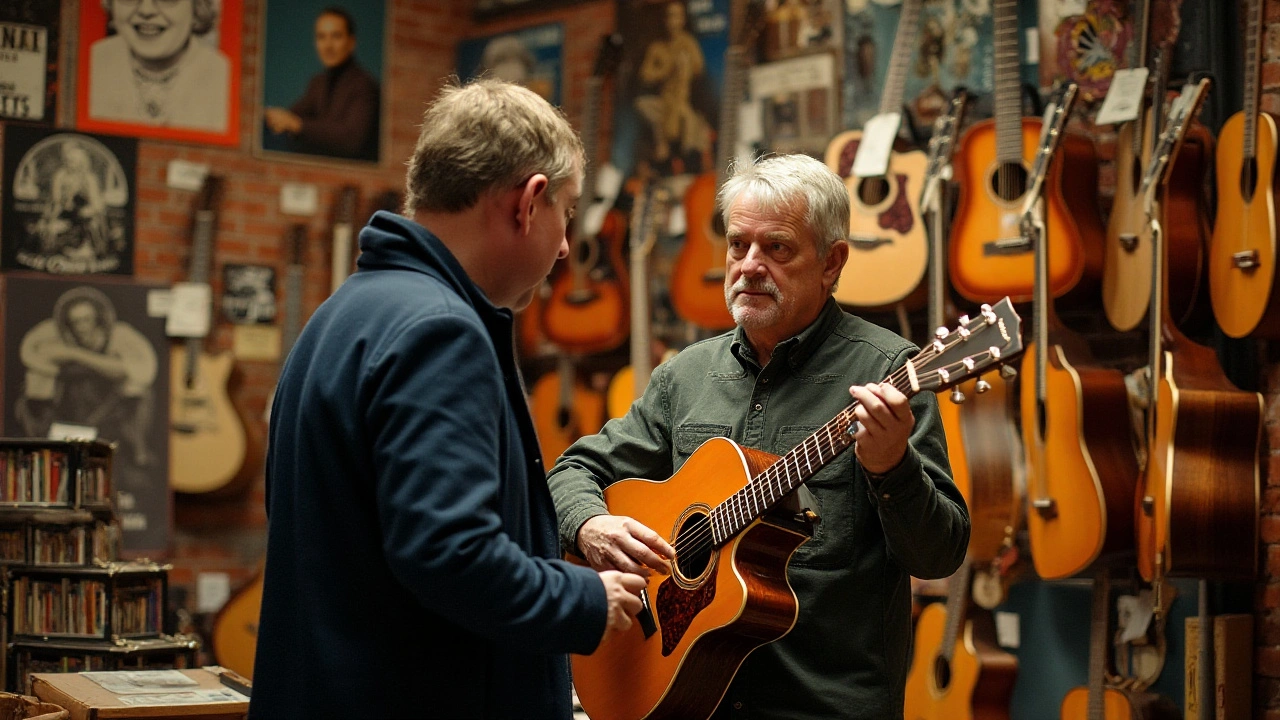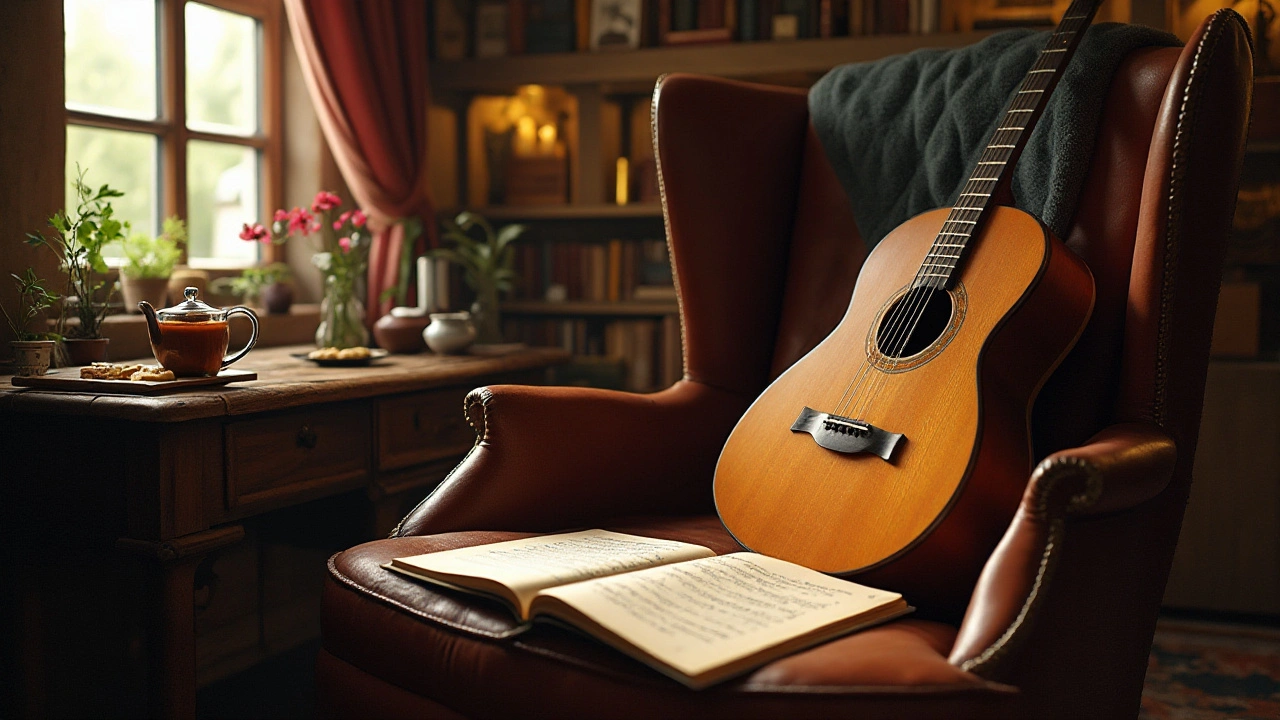The acoustic guitar is a truly magical instrument. From strumming campfire songs to performing on stage, its versatility makes it a favorite for many music enthusiasts. Whether you're just starting or looking to deepen your knowledge, this guide aims to demystify everything about the acoustic guitar.
We’ll cover different types available, the key parts that make up the instrument, and how to keep it in top shape. There will also be some helpful tips for beginners and interesting tidbits about its rich history. Let’s dive into the charming world of acoustic guitars!
- Introduction to Acoustic Guitars
- Different Types of Acoustic Guitars
- Parts of the Acoustic Guitar
- How to Maintain Your Guitar
- Tips for Beginners
- Interesting Facts and History
Introduction to Acoustic Guitars
The acoustic guitar is one of the most beloved musical instruments in the world. Its origins date back many centuries, evolving over time to become the versatile tool of expression we recognize today. One of the defining features of the acoustic guitar is its hollow body, which amplifies the sound produced by the vibrating strings without needing any electronic equipment. This makes it perfect for a wide range of musical genres, from folk to rock to classical music.
What really sets the acoustic guitar apart is its ability to produce such a rich, resonant sound purely through its construction. The sound hole, placed beneath the strings, acts as a natural amplifier, projecting the music in a way that captivates listeners. Different materials used in the construction of the guitar, such as spruce, mahogany, and rosewood, also contribute significantly to the tonal quality. For example, a spruce top produces a bright, clear sound, while mahogany provides a warmer, fuller tone.
Over the years, the acoustic guitar has seen many variations. There are the steel-string acoustic guitars, which are common in pop and folk music, and the classical guitars, which use nylon strings and are prevalent in traditional and classical music settings. Each type of acoustic guitar has its unique characteristics and appeals to different playing styles and preferences. Knowing the distinction between these types can help in choosing the right guitar tailored to one's musical ambitions.
"The guitar is a miniature orchestra in itself." – Ludwig van Beethoven
The journey of mastering the acoustic guitar can be incredibly rewarding, but it’s essential to start with a good foundation. For beginners, it is important to understand the basic anatomy of the guitar – the body, neck, headstock, frets, and tuners – as this knowledge will aid in everything from tuning the guitar to executing complex chords. Many new guitarists struggle initially with finger placement and building calluses, but persistence is key. With regular practice, the challenges faced in the beginning will soon become stepping stones towards beautiful music.
To summarize, the acoustic guitar's enduring popularity can be attributed to its simplicity, portability, and the profound depth of sound it is capable of producing. Whether played solo or in an ensemble, it remains one of the most versatile instruments around. As we delve deeper into the different aspects of the acoustic guitar in this guide, you'll gain a greater appreciation for this remarkable instrument’s design, history, and the sheer joy it brings to both players and listeners alike.
Different Types of Acoustic Guitars
Exploring the world of acoustic guitars can be both exciting and overwhelming given the variety available. Each type of guitar offers a unique sound and feel, suited for different styles and genres. Knowing the differences can help you choose the one that matches your musical journey best.
One of the most iconic types is the dreadnought guitar. Named after battleships due to its large, robust body, it delivers a rich, deep sound. This makes it a favorite choice for bluegrass and folk musicians. Another popular type is the parlor guitar, known for its smaller size and lighter tone. Often favored by fingerstyle players, the parlor guitar is perfect for intimate performances and smaller venues.
Don't overlook the jumbo guitar, famous for its large body and powerful sound. This type is ideal for performers seeking a bold, loud sound that can fill a room. On the other hand, the concert guitar sits comfortably between the parlor and dreadnought, offering a balanced tone that's versatile for various music genres.
For those who love classical music, the classical guitar with nylon strings is the go-to. Its softer, mellow sound is suited perfectly for fingerpicking and classical pieces. In contrast, the 12-string guitar offers a fuller and more resonant sound, giving chords a richer texture due to its additional strings. Often featured in rock and folk music, it adds an extra layer of depth to any performance.
Each type of acoustic guitar brings a different flavor to your music. Whether you’re strumming around a campfire or performing on stage, understanding the nuances of each type will help you find the right one to express your style. Remember, the best guitar for you is the one that feels comfortable and inspires you to play more.

Parts of the Acoustic Guitar
Diving into the anatomy of the acoustic guitar can help you appreciate the craftsmanship involved in its creation. Each part plays a unique role in producing the instrument's sound. Understanding these components will not only enhance your playing experience but also assist you in making informed decisions when purchasing or maintaining your guitar.
The main body, often referred to as the soundbox, is essential for amplifying the vibrations of the strings. It's usually crafted from wood, with spruce and mahogany being popular choices due to their lightweight and resonant qualities. The top piece of wood is called the soundboard, a critical element that shapes the *guitar's* tone. Inside the body, you'll find bracing that supports the structure and influences the sound projection.
The neck of the guitar is the long, slender part that extends from the body and holds the fretboard. This part is crucial for playability and comfort. The fretboard, generally made from rosewood or ebony, contains metal frets that help define the notes. At the end of this neck is the headstock, where tuning pegs are located. These pegs are twisted to tighten or loosen the strings, thereby tuning the guitar.
Attached to the neck is the nut, a small piece that guides the strings from the neck to the headstock. It helps in spacing the strings evenly and maintaining their height off the fretboard. The *bridge* on the body holds the other end of the strings. It is pivotal in transferring string vibrations to the soundboard. Bridges are typically made from hard woods like ebony and are carefully designed for maximum efficiency.
Another important part to note is the soundhole. This is usually located on the front of the body and allows sound to resonate within and then project outwards. The rosette, a decorative ring around the soundhole, often adds a touch of beauty and an extra layer of strength to this area.
According to renowned luthier Bob Taylor, "The relationship between the neck, body, and strings is almost symbiotic. Each part must complement the other to produce a harmonious and rich sound."
The strings themselves are also a fundamental component. Usually made from either nylon or steel, they can drastically alter the sound of the guitar. Nylon strings tend to offer a mellow, warm tone, making them suitable for classical music, while steel strings provide a bright, punchy sound often found in folk and rock genres.
Lastly, don't overlook the pickguard situated near the strings that protects the soundboard from scratches during intense strumming sessions. Although some guitars lack this feature, it can be quite handy for preserving the aesthetics of your instrument.
| Part | Material | Function |
|---|---|---|
| Soundboard | Spruce, Mahogany | Shapes Tone |
| Neck | Maple, Mahogany | Playability |
| Fretboard | Rosewood, Ebony | Note Definition |
| Bridge | Ebony | Transfer Vibrations |
Getting acquainted with these parts is a wonderful step towards mastering the acoustic guitar. Each element is meticulously designed to contribute to the overall rich and vibrant sound that has made the acoustic guitar a beloved instrument worldwide.
How to Maintain Your Guitar
Owning an acoustic guitar is a joyful experience, but keeping it in top-notch condition requires regular maintenance. Proper care ensures your guitar sounds great and lasts for years. One of the essential tasks is cleaning your guitar. Oils from your fingers, dust, and grime can accumulate on the strings and body, affecting the sound quality. Use a soft, dry cloth to wipe down the strings and body after each use. For deep cleaning, use a special guitar cleaning solution applied with a microfiber cloth.
Another critical aspect is tuning. Keeping your guitar in tune not only makes it sound better but also prevents string wear and tear. Use a reliable tuner and check tuning each time before you play. When your guitar isn't in use, store it in a case to protect it from humidity and temperature changes. Consider using a decent humidifier during dry months; wood is sensitive to environmental factors and can crack or warp.
Regularly changing your strings is another key maintenance task. Even with regular cleaning, strings wear out and lose their brightness over time. Typically, you should change the strings every three months or more often if you play daily. Always keep an eye out for any signs of wear on the strings, such as rust or fraying. When changing strings, do a quick inspection of the bridge and nut for any signs of damage.
Inspecting the Neck and Frets
The neck and frets of your guitar need your attention, too. Regularly check for any signs of bowing or warping of the neck. You can hold down the string at the first and last frets and check for any excessive gap at the mid-point. If you notice anything off, it might be time to adjust the truss rod. Frets can wear out over time, leading to buzzing or dead notes. If you spot uneven or worn frets, take your guitar to a professional for dressing or replacement.
Monitoring the Body
The body of the guitar is not just about looks but also affects sound quality. Keep an eye out for any cracks, dents, or other damage. Preventive care involves keeping the guitar out of direct sunlight and away from radiators to avoid heat damage. You should also be cautious about exposing it to extreme cold. If you're carrying your guitar around, use a padded gig bag or hard case for extra protection.
"The acoustic guitar is a delicate instrument, and proper care can go a long way," says renowned luthier John Doe.
By following these simple steps, you can ensure that your acoustic guitar remains in excellent condition. Regular maintenance might seem like a chore, but it's a small price to pay for the joy of playing a beautifully sounding instrument.

Tips for Beginners
When starting to learn the acoustic guitar, it’s important to approach the experience with patience and dedication. The first step is choosing the right guitar that suits your style and comfort. It might be tempting to go for a visually appealing option, but you should prioritize comfort, sound quality, and build. Visiting a music store to test different guitars can help make a more informed decision, and some experts suggest bringing along a seasoned player to help you choose.
Practicing regularly is key to mastering the guitar. Set aside a specific time each day for practice, even if it’s only for 20 minutes. Consistency builds muscle memory and improves finger dexterity. Start with basic chords such as G, C, and D major, and practice transitioning smoothly between them. Remember, it's okay to make mistakes; they are part of the learning process.
Many beginners often neglect proper posture while playing. Ensure you sit with a straight back and your feet flat on the ground. This avoids strain and helps with longer practice sessions. Holding the guitar correctly is crucial; the guitar's body should rest on your leg, and the neck should be at a comfortable angle. Avoid tilting the guitar upward or leaning over it excessively.
Learning to read and understand guitar tabs can significantly help. Tabs represent the positions where you need to place your fingers on the strings. However, developing an ear for music is equally important. It helps replicate songs more accurately and improvise better. There are numerous online resources and apps designed to help train your ear.
Joining a guitar class or group can be immensely beneficial. Not only does it provide structured learning, but it also offers a supportive community. Playing with others can elevate your skills faster than practicing alone. If group settings are not your style, consider taking private lessons from a certified instructor.
“Remember that the most successful musicians weren't born with innate talent; they worked hard, practiced daily, and never gave up.” - Anonymous Musician
Investing in a good quality tuner and learning how to tune your guitar correctly is another essential tip for beginners. A well-tuned guitar sounds much better and makes practicing more enjoyable. Most modern tuners are easy to use and come with clear instructions. Regularly tuning your guitar also helps identify possible issues with the instrument early on.
Lastly, don’t rush the learning process. Everyone progresses at their own pace. Patience and persistence are your best friends. Celebrate small milestones, whether it's mastering a new chord or learning to play your first song. These small victories keep you motivated and make the journey enjoyable.
Interesting Facts and History
The acoustic guitar has a rich history that spans centuries, contributing to its cultural significance today. The earliest stringed instruments date back to ancient civilizations. However, the acoustic guitar, as we know it, began taking shape in 15th-century Spain. Luthiers, or guitar makers, in Spain started to refine the design, creating an instrument similar to the modern classical guitar.
During the Renaissance period, the guitar wasn't just an instrument but an essential part of social gatherings and court music. It was in the 16th century when the five-course guitar was born. A 'course' refers to a pair of strings tuned to the same pitch, and this design laid the foundation for the six-string version we see now. By the late 18th century, the five-course guitar evolved into the six-string guitar.
Evolution in the 19th and 20th Century
The 19th century saw further transformations. Notably, in the 1850s, a German immigrant named Christian Frederick Martin revolutionized the world of acoustic guitars by developing the X-bracing system, which drastically improved the sturdiness and sound quality. His brand, Martin Guitars, remains one of the most respected in the industry today.
The early 20th century brought the dreadnought guitar, characterized by its large body and rich, loud sound. Introduced by Martin Guitars in 1916, the dreadnought became especially popular among folk musicians. Its name was inspired by a famous British battleship, symbolizing its powerful sound. Gibson also emerged as a significant name, manufacturing innovative designs, including the round-shouldered jumbo models.
In the mid-20th century, the folk revival in America, led by artists like Bob Dylan and Joni Mitchell, skyrocketed the popularity of acoustic guitars. They became symbols of social change and protest. During this period, the acoustic guitar was more than a musical instrument—it became a voice for a generation.
Interesting Facts Worth Sharing
Let's dive into some intriguing facts about the acoustic guitar:
- The world's oldest guitar-like instrument is a 3,500-year-old Hittite artifact known as a 'guitarre,' discovered in an Anatolian tomb.
- An acoustic guitar's tone is influenced not just by its shape and bracing but also by the type of wood used. For instance, mahogany produces a warm sound, while spruce offers clearer tones.
- The most expensive guitar ever sold at auction was a Martin acoustic owned by Kurt Cobain, sold for $6 million.
- Classical guitars differ from other acoustic guitars by their use of nylon strings, which produce a softer sound compared to steel strings commonly used in folk and rock music.
- In the 1960s, José Ramirez III developed the ‘Ramirez’ bracing pattern, which became a key design in classical guitars. It's still revered by classical guitarists today.
"The history and evolution of the guitar represent humanity’s journey, constantly evolving and never losing its essence.” - John Williams, classical guitarist.
From ancient relics to modern masterpieces, the acoustic guitar continues to captivate players and audiences worldwide. Its ability to adapt while maintaining a timeless allure ensures its place in music for generations to come.

